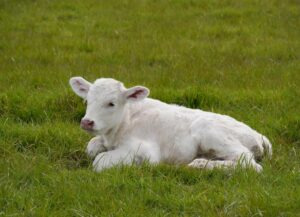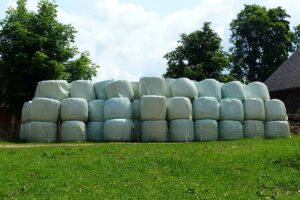Álvaro García
There is a current trend in consumers preference for dairy products obtained from feeding cattle with locally sourced, non-genetically modified crops that can be traced to their origin. As a result, locally produced vegetable proteins in Europe have been partially replacing imported soybean meal.
Fava beans nutrient composition
Legume plant species such as fava beans, have the same nitrogen-fixating properties as soybeans, and yields bordering 3 tons per hectare. Their nutrient content is quite high at approximately 30% protein and 44% starch.
This protein however is almost 80% fermentable in the rumen making necessary the supplementation of bypass protein particularly in high producing dairy cows. Various processing technologies have been used to increase this undegradable protein (bypass) fraction with the most common being heat treatment.
Protein protection
This treatment is quite effective provided temperature, time, and moisture during treatment are maintained within certain parameters. When this processing exceeds the recommended temperature, for example, heat damage occurs which reducers both protein and sugar availabilities to the animal (Maillard reaction).
Most heat-treated raw seeds do not undergo any previous treatment before extrusion. There could be however some treatments that could make the process more effective without excessively damaging the protein.
An experiment conducted recently (Mendowski et al., 2020) explored treatment before extrusion, with the objective to protect fava beans protein from damage, while maintaining adequate utilization and performance in dairy cows.
It was hypothesized that these proteins could still be protected from rumen degradation while the addition of reducing sugars or an enzymatic cocktail pre-extrusion would improve this protection.
Reducing sugars form complexes with proteins (Maillard reaction) during the heating process. The enzymatic cocktail proposed may also hydrolyze sugars from starch leaving them available to form similar complexes with proteins.
Multiparous lactating Holstein cows with 2.9 ± 0.9 lactations, a BW of 690 ± 29 kg, DIM of 96 ± 27 d, were allocated in 4 balanced groups based on intake, parity, DIM, and milk yield and composition. The four groups of cows received successively 4 dietary treatments in a 4 × 4 Latin square design. Within group, all cows received simultaneously a similar diet and then measuring feed intake, milk production and composition, nutrient digestibility and nitrogen partitioning.
Two cows were fitted with a rumen cannula to measure ruminal parameters. There were 4 experimental periods of 28 d, with 22 days for adaptation to the diet, and then 6 days for data collection.
The 4 experimental diets were iso-nitrogenous and iso-energetic, contained 56% forage and 44% concentrate in a dry matter (DM) basis; were fed at 95% of ad-libitum intake.
They also had more than 35.0% neutral-detergent-fiber (NDF) in a DM basis, with 28.0 NDF from forage, and less than 20.0% of degradable starch (to prevent ruminal acidosis). Feeds used were the same blend of corn silage, direct cut grass silage, hay, dehydrated beet pulp, and beet molasses. All diets included 0.65% urea to make sure there was enough soluble nitrogen for rumen microorganisms. There was also protected methionine added to the diet at 85 g/day. The concentrate consisted of fava beans:linseed blends (90:10%, raw basis) distributed either as:
- Raw (control),
- Extruded after pretreatment without additive,
- Extruded after pretreatment with reducing sugars,
- Extruded after pretreatment with an enzymatic cocktail.
Adding reducing sugars or enzymatic cocktail during pretreatment improves protein utilization
Adding reducing sugars or an enzymatic cocktail during pretreatment increased Maillard compounds in the extruded blends and increased (+50 mg/L) rumen ammonia content. Extrusion without additives also increased Maillard compounds, reduced enzymatic protein degradability, reduced (numerically) rumen ammonia, and showed a trend for higher plasma essential amino acid concentrations.
This suggested a shift on the site of protein utilization with less breakdown in the rumen and likely higher absorption in the small intestine. With reducing sugars, digestibility of lysine was numerically lower, and plasma essential amino acid concentration tended to decrease.
Pretreatment with reducing sugars led to lower concentrations of some plasma amino acids, suggesting over-protection of proteins resulted in decreased absorption. With the enzymatic cocktail, plasma essential amino acid concentration was similar than without the additive pretreatment, suggesting similar metabolizable protein supply with both treatments.
Pretreating with amylases led to a similar concentration of amino acids in plasma compared to the extruded blend without additive, likely because of similar intestinal absorption.
Results of this experiment confirmed that extrusion at 140°C improves the utilization of proteins from fava beans in ruminants. Adding reducing sugars or amylases pre-extrusion requires additional steps in order to achieve protein protection from rumen degradation. No changes in nitrogen partitioning between milk, urine, and feces were observed regardless of the diet.
Reference
S Mendowski, P Chapoutot, G Chesneau, A Ferlay, F Enjalbert, G Cantalapiedra-Hijar, A Germain, P Nozière. Effects of pretreatment with reducing sugars or an enzymatic cocktail before extrusion of fava bean on nitrogen metabolism and performance of dairy cows. J Dairy Sci. 2020 Jan;103(1):396-409.
© 2020 Dairy Knowledge Center. All Rights Reserved.











